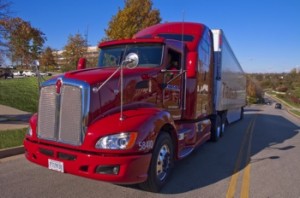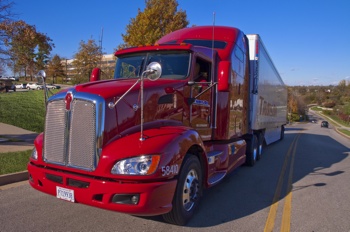SmartWay, as you know, is a voluntary EPA program that was rolled out in 2004 to promote reducing greenhouse gas emissions by commercial vehicles – primarily by improving fuel economy – using an array of means impacting tractors, trailers, engines, aerodynamics, brakes and, of course, tires.
CARB refers to the California Air Resources Board, which has both driven and piggybacked on the success of the SmartWay program. Class 7-8 trucks driving in California must meet specific standards; particularly the use of EPA SmartWay verified aerodynamic technologies and low rolling resistance tires.
In basic terms, there are five components of the SmartWay program:
• Transport Partnership: Works with freight carriers and shippers to benchmark operations, track fuel consumption and improve performance.
• SmartWay Vehicle Program: Identifies light-duty cars and small trucks that demonstrate superior fuel efficiency.
• Finance Program: Makes investing in fuel-saving equipment easier for trucking fleets.
• International Interests: Provides guidance and resources to countries that want to develop similar programs.
• Technology Program: A testing, verification and designation program to help fleets identify equipment and technologies that save fuel and lower emissions.
Low rolling resistance tires fall under this Smart-Way tech program for both new tires and retreads.
Getting Verified
EPA’s SmartWay Technology Program develops test protocols, reviews strategies and verifies the performance of vehicles, products and equipment that have the potential to improve fuel efficiency and reduce greenhouse gases and other pollutants from freight transport.
This program establishes credible performance criteria and reviews test data to ensure that vehicles, equipment and technologies will help fleets improve their efficiency and reduce emissions. The SmartWay staff is based in Washington, D.C., with a major facility located in Ann Arbor, Mich.
The SmartWay technology program has concentrated efforts on vehicle aerodynamic devices, idling reduction, and fuel-efficient (low rolling resistance) new tires and retreads. They also have an additional category called Retrofit Technologies, which include diesel oxidation catalysts and diesel particulate filters. If SmartWay determines a specific technology offers significant reduction in greenhouse gas emissions then SmartWay considers it a “verified technology.”

SmartWay has developed a tire verification process and utilizes data supplied by tire manufacturers. The tire producers must demonstrate that a particular tire model has a rolling friction coefficient at or below target values. If the new tire or retread shows a 3% or more reduction in rolling resistance versus a baseline tire, then that tire is now on the “verified technology” list. This testing is done using SAE rolling resistance test standards on a 67-in. wheel dynamometer.
As of this writing, 72 unique brands have SmartWay-verified products listed by the EPA, a roster that includes 162 steer tires, 183 drive radials and 85 trailer axle tires – 430 total tire models.
The complete list of verified new tires and retreads can be found on the SmartWay website at epa.gov/smartway/forpartners/technology.htm. The list is updated on a regular basis.
ROI Analysis for Fleets
Even though a new tire or retread makes the SmartWay verified technology list it does not imply that all the tires have equivalent rolling resistance or fuel economy. The tires on the list simply meet a threshold level of rolling resistance.
Fleets need to run their own evaluations to determine which fuel-efficient tire actually delivers the best performance on their vehicles and for their application. Specific tread design, tread depth and compounding all have an impact on tire rolling resistance.
A shallower initial tread depth will actually help reduce rolling resistance. In some cases, removal miles have been reported to be slightly lower because a tire has a shallower initial tread depth oriented to greater fuel economy.
This is why it is always important for each fleet to run a complete ROI analysis to determine the exact payback for a particular fuel-efficient tire.
Vehicle fuel economy improvement has the biggest financial impact on line haul fleets. Even a 1% or 2% improvement in miles/gallon can save a fleet millions of dollars per year.
Fuel-efficient tires typically have a price premium attached because of the specialized raw materials and construction employed to deliver lower rolling resistance. Running tires underinflated will wipe out any advantage of spec’ing fuel-efficient tires. Super wide tires will have improved fuel economy versus running a pair of conventional duals; a super single and its wheel weigh less than conventional duals. That’s a savings before even considering any reduced rolling resistance from construction and compounding.
Maintaining proper tire inflation pressure with super wide radials is very important. Running super wides underinflated will lead to high heat buildup, which significantly reduces fuel economy and adversely affects casing retreadability.
And always remember that air carries the load; this is why the recommended tire inflation pressures are based on the worst-case load scenario for a specific vehicle configuration.
CARB and Fleets
Let’s take a look at what is required to run trucks in California. CARB has a regulation that mandates SmartWay-verified low rolling resistance new tires and/or retreads. This regulation applies to all tractors and 53-ft. or longer box-type trailers – including dry-vans and refrigerated trailers.
The California regulation includes both super wides and conventional duals. As long as the tires are listed on the SmartWay-verified technology list, the tires are the in compliance.
Tire dealers need to fully understand both SmartWay and CARB programs when it comes to tires. Fleets continue to count on their tire dealers to provide the best fuel efficient tires with the best overall performance when it comes to traction, removal miles, and of course, retreadability.
Staying on top of current regulations and the latest in fuel-efficient radial tires to keep you on your fleet customers’ “verified” list.














